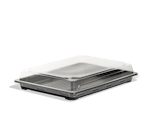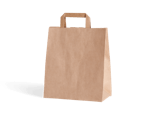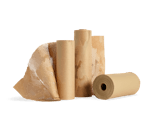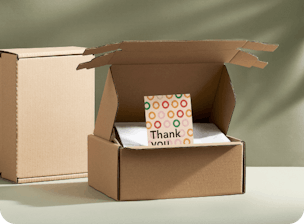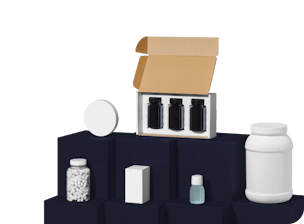CASE STUDY
Mushrooms-based Packaging? That's IKEA's Concept of Sustainable Supply Chain

IKEA has cut its packaging usage by 50% over the last few years, and continues its journey into more sustainable packaging by exploring new plant-based materials.
The Swedish giant has been continuously optimizing its packaging over the years. And it pays off. As reported back in 2015, their packaging was responsible for € 1.2 million savings via a series of optimizations. Now, the company has taken the course for sustainability. By implementing a mix of plant-based alternatives to plastic, along with further optimizations of their cardboard-based packages, IKEA is still the benchmark for all e-commerce and retail brands around the world.

Topics
Innovative materials
Packaging cost optimization
Focus on sustainability
Global packaging supply chain

Key insights
Plant-based packaging as a way of removing plastic from the packaging supply chain
90% of reduction of carbon emissions achieved through packaging optimization
A mix of fiber-based and plant-based packaging for different customer use cases
Supply chain challenges
Challenges of a global packaging supply chain for IKEA
The furniture & home design chain has now 433 stores in the whole world, and its new smaller concept stores will appeal to new segments of customers. As a result, IKEA deals with an incredibly complex packaging supply chain to work with.
In regard to products range, IKEA’s shop comprises of thousands of products, each one with different shapes and needs in terms of packaging. When you add high maintenance costs for these enormous storage spaces, as well as the need for economies of scope within such diversity of packaging solutions, it’s a quite a challenge all together.
In this layered supply chain, even the smallest change brings significant results. With more than 12.000 products, warehouses and complex logistics chain, IKEA needed a very firm solution for all its deliveries and in-store packaging.


Product portfolio

Sustainability

Supply chain
Innovative packaging
Mushroom-based packaging
Earlier in 2019, the company announced the implementation of mushroom-based packaging, based on mycelium and agricultural cultivation of the source material. The innovative concept is a next step in decreasing the amount of EPS-based packaging used by the company.
This innovative material means lots of benefits for the environment:
- less marine waste,
- a massive reduction of 90% in carbon emissions,
- and less energy used in the production process.
Given the company’s size and potential influence, this innovative packaging can decrease the worrying numbers in the packaging industry, where more than 50% of packaging is still made from plastic. Furthermore, IKEA has always been associated with a cutting-edge approach in terms of combining the company’s growth with sustainability.

Cardboard-based packaging
Over 90% of packaging used for deliveries of IKEA is fiber-based boxes
Cardboard and paper are key to IKEA’s products, and these two materials are highly eco-friendly too. The mycelium-based alternative helps to eliminate the plastic inserts and lightweight products for smaller products available in IKEA’s offer. But cardboard and paper helped to remove EPS (expanded polystyrene) packaging from the supply chain of IKEA.
As of 2019, out of over 900,000 tons of packaging produced by IKEA annually, more than 92% is fiber-based. Furthermore, most of it can be easily recycled, much easier than expanded polystyrene. And this is also the key learning from Packhelp Pro projects – our customers choose corrugated cardboard because it’s a great alternative to any plastic-based solutions for shipping.
Allan Dickner, Manager of Packaging Development at IKEA of Sweden explained also that more than 75% of customers bring the products home on their own, and cardboard is appreciated for its high durability. Dickner also said that this corrugated-cardboard box is the first touchpoint for online buyers. And with IKEA’s plans to further push online sales, these boxes become an essential branding and experience medium.

Expert opinion
Artur Oboleński, Head of Packhelp Lab, shares his views on the supply chain strategy of IKEA.
The switch from EPS to cardboard
Product shipping security is expected from any kind of packaging – it is one of its core functions. EPS does just that and it is cheap, available and easy to make. However, it’s also too cheap, too available, too easy to make… and hard to decompose. Filling the box space with alternative but possibly light, soft enough and inexpensive material – is a challenge.
Building their packaging strategy around cardboard and paper helped IKEA to make a significant step towards sustainability. And we see it in the case of many of our customers at Packhelp too. By analyzing the complexity of its own packaging supply chain, each company should be able to identify space where such eco-friendly solutions can be implemented.
Highlights
92%
of shipping packaging of IKEA is fiber-based, and is easily recyclable
90%
less of carbon emissions is generated by new, mushroom-based packaging
900.000
tones of packaging is produced annually by IKEA

Expert opinion
Finding alternative materials
Plant-based packaging – whether it is fibre or biopolymers – provides brands with fact-based sustainability credentials. It is even more so in the light of ocean littering concerns and the latest regulations, especially in the EU. The increasing costs of compliance, propelled by the public demand, are meant to offset the price we all have been paying for years anyway – be it polluted air or smelly landscapes with heaps of trash.
I cheer on the IKEA team not only because they made a great idea work but – with their portfolio range and supply chain complexity – it is hard to overstate the effort made (and still to be made too). R&D investment must have been significant and there is still risk associated with the implementation of any new material. Evident sourcing risk connected with new solution and short-lived manufacturing needs another mitigation plan.

Expert opinion
Global effect
I also welcome the impact this project will potentially and hopefully have on other global brands. Another effect is cash injection into new economy players, such as green startups focused on material engineering. It has the potential of educating global shopper (“it can’t be mushroom! Really??”).
Going forward, IKEA will have to focus on optimizing supply chain of the solution, its global operations will require smart mapping of packaging plants to reflect the network of furniture manufacture. There must be a great potential in developing the vendors – initiatives to address sourcing security through manufacturing efficiency and development of more effective methods. It will have to touch on consistency in quality so the functionality of the inserts is maintained. All the hard work – done and to be done – will pay off in the consumer loyalty who will realize that after all someone does care.





























